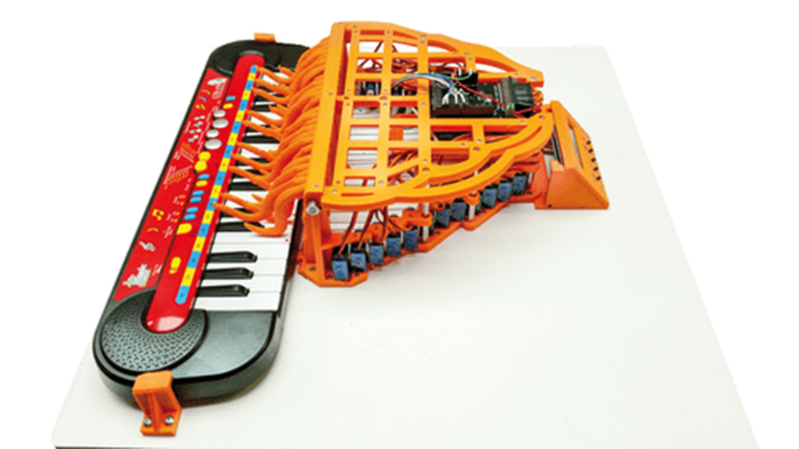MIDI has been around for nearly forty years, but what do you do if you have an old ‘toy’ keyboard without MIDI? Or really any way to make it sound good? You could turn it into a player piano, and that’s exactly what [Alessandro] did with an old toy keyboard. It’s The Pianist Octopus, and it is perhaps the coolest, neatest pianist you’ve ever seen.
This build uses 24 individual 9 gram hobby servos, which of course means you need to drive those servos somehow. There are plenty of ways to attach a few servos to an Arduino board, but when you need to drive 24 servos, your options become somewhat limited. The electronics consist mostly of a Fishino Octopus, an Arduino shield that can drive sixteen individual servos. Slap two of these shields on an Arduino and you have something that will drive twenty four servos.
The mechanical part of the build consists of a 3D printed frame that allows the servos to be mounted across an arc, something like a harp. Metal rods connect the servos to tentacle-shaped actuators. These were designed in Google SketchUp and printed in PLA.
Attached to these servos and Arduino is a character LCD and a few buttons that allow the user to cycle through a few functions. The play button plays the current melody (based on old Nokia ringtones, by the way), a few more buttons adjust the position of the individual servos, and there’s another button to stop playing. Since this is a complete electronic-to-mechanical interface for a toy piano, a MIDI-in port isn’t out of the question; all a MIDI implementation would need to do is move a servo down on a note on event and move it back up on the note off event.



















Vigintiquattuoropus surely?
Very cool, but I’m overlooking the video. Surely there must be one?
A second rod across the bottom with half the tentacles ‘hinged’ the other direction would allow a single servo to push/pull for striking two adjacent keys, requiring only half as many servos and a single driver board.
Octo-plexing circuit?
B^)
Ha!
But surely proper octoplexing would be a mechanical marvel (rube goldberg) that would take 8 movement outputs from a single servo and strike one of 8 keys!
“A second rod across the bottom with half the tentacles ‘hinged’ the other direction would allow a single servo to push/pull for striking two adjacent keys,”
but how would you play both keys at the same time?
Yeo can find the video here https://www.open-electronics.org/octopus-a-tentacular-shield-for-arduino-and-fishino/
Now the octopus thing really makes sense!
“a 3D printed frame that allows the servos to be mounted across an arc, something like a harp.”
So…
if you use one to play a “real” piano, (mechanical) which has a the wires strung on a harp, you will use a harp to play a harp.
It’s time for me to stop harping about this…
A joke is needed. What’s worse than an octopus on a piano? A crab on an organ.
Would that organ be a 12 inch pianist?
There was a device called an auto-Pianola built in the 1920’s that was a little bit like this, and they are amazing to watch. https://www.youtube.com/watch?v=4jfEqkNHIfo is a video of one. It accepts a standard player piano perforated paper roll, and the person playing it pumps the pedals which run a three-phase pneumatic pump, that drives a set of levers that play about 3/4 of the keys of a standard piano. I’ve gotten to play the one in the video, but they’re way more fun to watch than to play.
I’m glad someone else has notices the 3-phase pumps used in these machines! I got to take a close look at a multi-instrument machine a while ago and pumps (vacuum and pressure) stood out to me as a great example of why a 3-phase supply + rectifier gives a steadier voltage than single phase.
The full project is here https://www.open-electronics.org/octopus-a-tentacular-shield-for-arduino-and-fishino/